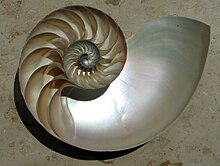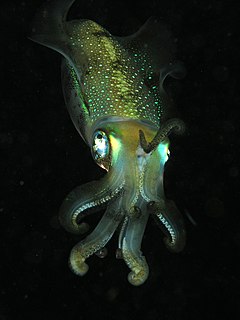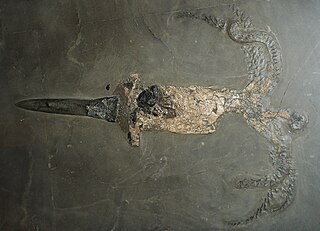
The phragmocone is the chambered portion of the shell of a cephalopod. It is divided by septa into camerae.

A cephalopod is any member of the molluscan class Cephalopoda such as a squid, octopus or nautilus. These exclusively marine animals are characterized by bilateral body symmetry, a prominent head, and a set of arms or tentacles modified from the primitive molluscan foot. Fishermen sometimes call them inkfish, referring to their common ability to squirt ink. The study of cephalopods is a branch of malacology known as teuthology.

Camerae are the spaces or chambers enclosed between two adjacent septa in the phragmocone of a nautiloid or ammonoid cephalopod. These can be seen in cross-sections of a nautilus shell and in the polished cross-sections of ammonites. In life these chambers are filled with gas, mediated by the siphuncle, and used to control buoyancy.
In most nautiloids and ammonoids, the phragmocone is a long, straight, curved, or coiled structure, in which the camarae are linked by a siphuncle which determines buoyancy by means of gas exchange.

Nautiloids are a large and diverse group of marine cephalopods (Mollusca) belonging to the subclass Nautiloidea that began in the Late Cambrian and are represented today by the living Nautilus and Allonautilus. Nautiloids flourished during the early Paleozoic era, where they constituted the main predatory animals, and developed an extraordinary diversity of shell shapes and forms. Some 2,500 species of fossil nautiloids are known, but only a handful of species survive to the present day.

Ammonoids are an extinct group of marine mollusc animals in the subclass Ammonoidea of the class Cephalopoda. These molluscs, commonly referred to as ammonites, are more closely related to living coleoids than they are to shelled nautiloids such as the living Nautilus species. The earliest ammonites appear during the Devonian, and the last species died out in the Cretaceous–Paleogene extinction event.

The siphuncle is a strand of tissue passing longitudinally through the shell of a cephalopod mollusk. Only cephalopods with chambered shells have siphuncles, such as the extinct ammonites and belemnites, and the living nautiluses, cuttlefish, and Spirula. In the case of the cuttlefish, the siphuncle is indistinct and connects all the small chambers of that animal's highly modified shell; in the other cephalopods it is thread-like and passes through small openings in the walls dividing the chambers.
Despite this benefit, such a large shell adds to the mass of the animal, and hence is disadvantageous in catching fast-moving prey. Some nautiloids, such as the Silurian Ascocerida, dropped the phragmocone upon maturity, presumably to increase speed and maneuverability. They thus became the early Paleozoic equivalent of coleoids. The early coleoids and belemnoids adopted a different approach: the phragmocone was retained but became internal and reduced. In general the shell in cephalopods tends to be vestigial or absent.
The Silurian is a geologic period and system spanning 24.6 million years from the end of the Ordovician Period, at 443.8 million years ago (Mya), to the beginning of the Devonian Period, 419.2 Mya. The Silurian is the shortest period of the Paleozoic Era. As with other geologic periods, the rock beds that define the period's start and end are well identified, but the exact dates are uncertain by several million years. The base of the Silurian is set at a series of major Ordovician–Silurian extinction events when up to 60% of marine genera were wiped out.

The Ascocerida are comparatively small, bizarre Orthoceratoids known only from Ordovician and Silurian sediments in Europe and North America, uniquely characterized by a deciduous conch consisting of a longiconic juvenile portion and an inflated breviconic adult portion that separate sometime in maturity.
The PaleozoicEra is the earliest of three geologic eras of the Phanerozoic Eon. It is the longest of the Phanerozoic eras, lasting from 541 to 251.902 million years ago, and is subdivided into six geologic periods : the Cambrian, Ordovician, Silurian, Devonian, Carboniferous, and Permian. The Paleozoic comes after the Neoproterozoic Era of the Proterozoic Eon and is followed by the Mesozoic Era.








